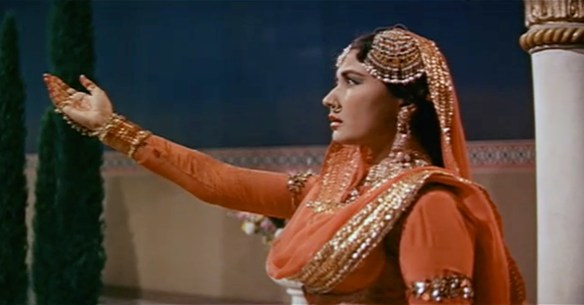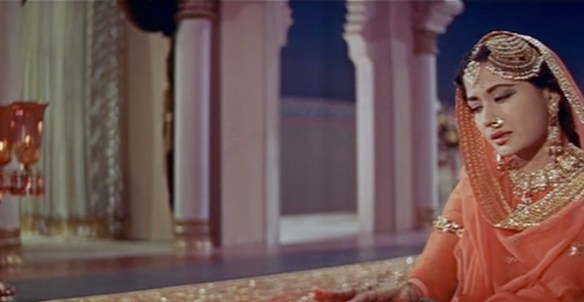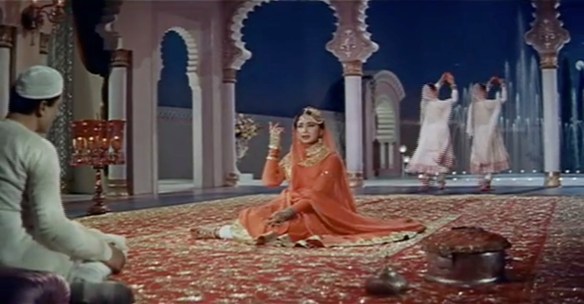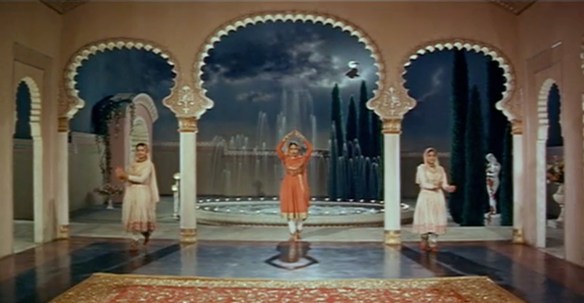For our next song, we provide an English translation of the timeless lyrics of Pakeezah’s “Chalte Chalte.” The film Pakeezah (1971) instantly reached legendary Bollywood status upon its release, due in part to the ethereal musical score, brilliant Urdu dialogue, lavish sets, but also from its star Meena Kumari’s untimely death within a week of the premiere. This song is known everywhere, and the beauty of Meena and Lata’s performance truly speaks for itself. My parents have old home videos of 4-year-old me draping a chunni on my head and attempting to dance and sing along with her during this song. It’s hard to put that kind of impact into words, but you can tell it’s profound.
Anyway.
An interesting facet of this song is the interwoven theme of the train ride. For anyone familiar with film theory, “the train” has a fascinating and critically important role in cinematic history across the globe. Likened to films themselves, the train transports you to a different world and takes you on a brief journey that can leave you different from when you started. It is a theme heavily explored by early French filmmakers first experimenting with the medium (you may remember the loving references to the Lumiere brother’s Arrival of a Train at La Ciotat Station (1895) in Hugo!), and in Indian cinema, trains play no less an important role. Like Satyajit Ray’s famous Pather Panchali (1955) which pivoted on the introduction of a train whistle across the quiet sugarcane fields, so too does the world of Pakeezah hinge on the sound of a distant train whistle incorporated into the score at the end of the song. For trains can represent that journey from tradition to modernity, from reality to fantasy, and for Pakeezah as well as Kamal Amrohi’s viewers entering a hidden, dying world of ornamentation, the train is a vehicle of escape.

Gesturing to the moon, Meena Kumari waits for her mysterious admirer to find her again in Pakeezah (1971)
“Chalte Chalte” will absolutely leave you wishing for more, so make sure you watch the movie if you ever want to claim cultural competency. To read more about this film, check out our post on behind-the-scenes Pakeezah trivia! Enjoy our full lyrics and English translation to “Chalte Chalte” below!
Chalte Chalte Lyrics and Translation:
Chalte chalte yuu.N hii koi mil gaya tha
I met someone by chance while walking
Sare raah chalte chalte
Walking around the path
Wohii thamke rah gayii hai
The night suddenly came to a standstill
Meri raat dhalte dhalte
Just as it was about to fade away
Jo kahii gayii na mujhse
What I was unable to voice
Woh zamaanaa keh rahaa hai
The world is now saying
Ki fasaanaa ban gayii hai
That a fable has been created
Meri baat talte talte
From those words which evaded me
Shab-e-intezaar aakhir kabhi hogi mukhtasar bhi
That night of waiting will after all shorten soon
Yeh chiraag bhuj rahi hai
These lamps are dying
Mere saath jalte jalte
As they burn alongside me
Glossary:
raah: path; zamaanaa: the world; fasaanaa: fable, legend; baat: words, incident, matter; talna: to evade, to escape; shab-e-intezaar: night of waiting; mukhtasar: short, soon; chiraag: flame
It’s always slightly bothered me that after the first antra the two back-up dancers start twirling, and after the second turn, get completely off-sync since the genius on the right goes a little too fast for the music. Kamal Amrohi cuts quickly to the next shot when this starts happening, so you might say it’s not a huge deal per se, but for someone who was such a neurotic perfectionist, how did this slip by him? It just gets to me every time. Or am I over-thinking this?
-Mrs. 55




A soundtrack that never grows stale! In response to your slight and justified miff about the background dancers there are two trains(sorry) of thought. One is that they are dancers and should be perfectly balanced and equal. The second is that they are part of the background for Meena and hence part of the set so even though it appears to be symmetrical it really is not, as you can see there is a slight imbalance(notice the trees, statue, etc). It is the just off balance in perfection that makes for a very good set and that is what the background dancers are achieving and making Meena look even better.
Haha, a great point actually! Watching those two jokers get off sync truly makes you appreciate the graceful perfection that is the leading lady, Meena–so in that sense, I agree, they do enhance!
If you will permit me one more moment to look at this since it is so brilliantly done, you will notice the colors are a simple mehndi/white/gold scheme played out in the drama of night. Of course everything is done to enhance Meena! She is deliberately the focal point in eye catching mehndi/gold and seems to be a part of a dark mehndi carpet she is sitting on, with neutral colors surrounding to enhance her. The only other mehndi colors you see is a mehndi flame flickering near her and softened mehndi tones in the wall above which are pulled around to again enhance her. The dancing girls are made to look like and blend into the neutral colors of the pillars. Meena standing is enhanced by the large fountain behind, again the total focal point in the picture where the color of her outfit, a dramatic mehndi color, pushes her clearly into the center stage to achieve architectural balance.
Wow! Fantastic analysis–you sound like a production designer!
Pingback: The Immortal Dialogue of Pakeezah « Mr. & Mrs. 55 – Classic Bollywood Revisited!
Pingback: Mausam Hai Aashiqana Lyrics and Translation: Let’s Learn Urdu Hindi « Mr. & Mrs. 55 – Classic Bollywood Revisited!
Just thought I would point out, I’m pretty sure it’s “muqtasar” and not “mukhtasar”. It comes from an Arabic word meaning “limited”.
These posts are incredible and I’m going to spend the next few hours delving into them – so well done!
Thank you for reading! Regarding the word “mukhtasar,” it is spelled with the Urdu letter khe not qaaf: مختصر. Thus, we have chosen to transliterate this word with a kh instead of q.
Did you know that there is “Inhi Logon Ne” version by Shamshad Begum
from Himmat (1942) by Pt. Gobindram – Aziz Kashmiri
You might find it in youtube.
Yup! Check out our earlier post on “behind-the-scenes” Pakeezah trivia to learn about the Shamshad version and more!
Pingback: Inhi Logon Ne Lyrics and Translation: Let’s Learn Urdu-Hindi | Mr. & Mrs. 55 - Classic Bollywood Revisited!
Pingback: Teer-e Nazar Dekhenge Lyrics and Translation: Let’s Learn Urdu-Hindi | Mr. & Mrs. 55 - Classic Bollywood Revisited!
when will you do a post on thare rahiyo? thanks!
I love love love this song! Thank you for your translation – Though I am of Indian origin, (my grandparents were from India), I am not fluent in any Indian language. However, I am sad that you belittle the 2 background dancers, referring to them as jokers. For me, they did a superb job, and would not be a part of the song or even of the movie, had ithe director not wanted them to be there. I believe they enhance the song and Meena Kumari’s performance. And ofcourse, I just love Meena Kumari!!!!
Beautiful translation
i m also indian origin but 3rd generation away from India.
Educated in English Medium but can speak average Urdu n Hindi.
Our Indian Culture is so rich n colourful n beautiful in many many aspects.
Pakeeza is an Icon with Evergreen Meena Kumari & Kamal Amrohi.
For Heritage & Appreciation sake we should have all the wonderful Pakeeza songs translated & analysed & commented. A.D.
THANK YOU! This website has taken away much loneliness from a South African Indian (3rd generation – 40 something) who has NOBODY to share this with cos this music and performances cannot be appreciated by my peers. This song is permanently on my favourite list, only because it speaks of a manner in relationships that has died a long time ago. Intezaar, pondering, staring into space, getting “lost” so to speak. As for the dancers, oh well it didn’t diminish the value of this performance at all so don’t hurt yourself LOL
The song is an absolute treat to listen,and even more beautiful to watch.The sarangi played in the beginning,and the train whistle in the end are perhaps the most beautiful pieces of music in the film,but there are innumerable others.
The most beautiful part is certainly the moment when sahibjaan extends her hands towards the moon and sings “yeh chiraag bujh rahe hain”,it sounds so soothing and otherworldly.Even the music stops before lata renders this line,as if the entire world has ground to a standstill with the dying lamps and all that remains is sahibjaan’s restless heart.